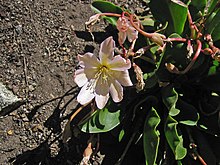User:Ttaylor0713
| Lewisia Tweedyi | |
|---|---|

| |
| Lewisia Tweedyi | |
| Scientific classification | |
| Kingdom: | |
| (unranked): | |
| (unranked): | |
| Order: | |
| Family: | |
| Genus: | |
| Species: | Tweedyi
|
| Binomial name | |
| Lewisia Tweedyi | |
Lewisia Tweedyi, is an angiosperm and has been praised for its beauty. It is a species of the Portulacaceae family. There are over 20 species in Western North America yet they are rare due to scarcity. These flowers usually have a coral, apricot, color but extremely pink forms of these flowers do exist both in its alpine home and in cultivation.
Distribution[edit]
Lewisia Tweedyi is native to crevices in the Wenatchee Mountains of Washington State. They can be found stationed at Mount Stuart, Tumwater Greek, Chumstick Creek, as well as places that are at the top of high ridges.
Habitat and Ecology[edit]
Lewisia Tweedyi is perennial. It is typically found at elevation of 1500 to 4500 feet. It hides from the sun at low elevations and can be found in the shade. As the elevations increase, the plant reveals itself to the sun. In wet climates, if the crown of the plant gets wet the crown will die causing the death of the entire plant. If cultured, perfect drainage is required for survival. The use of broken or crushed rock mixed with humus will keep the plant alive. Placing a small rock under the crowns can prevent the crown from getting wet. It is important for the crown to stay dry since it is the most vulnerable part of the plant. The plant will not die of thirst because the leathery leaves and roots will store enough water. They can live up to temperatures of 100 degrees in the summer time. In their native environment they can handle temperature below 30 degrees although the flowers may die but not the roots.
Morphology[edit]
The root of Lewisia Tweedyi is extremely thick and its root can grow to be two to three feet long although some are much shorter. There is a basal portion below the crown which is much larger than those in other Lewisias. There are numerous, evergreen, smooth, succulent and light green leaves. The margins on the leaves are up to a foot long including the stems. The blades of the leaves are sometimes shallowly notched at the apex and are up to two inches wide and are ovate. The petioles are three-eighths of an inch wide and are as long as the blades. The petioles appear flattened and the edges are turned upward forming a shallow groove that is at the base. On the underside of the stem, it is ridged at the base. A mature plant will be eight inches in diameter.
Flowers and fruit[edit]
The flowers of Lewisia Tweedyi, when matured, have thin small bracts. Along the stem are several scattered buds. There are eight to twelve broad petals that when mature will open widely creating what appears to be a cup-shaped blossom. These petals are up to three inches in diameter with a cream colored such as apricot or pink near the tips of the petals. The petals are not individualist. As they age, they close and cling together being replaced by the lower petals. Inside of their small egg-shaped capsule contains up to 12 to 20 seeds. There are 12 to 15 stamens and 2 sepals. This plant does not produce any fruit. Lewisia Tweedyi flowers in May, June, and July but it depends on their elevation in the Wenatchee Mountains.
References[edit]
Wiley, Leonard. Rare Wild Flowers of North America. Portland, Oregon. Wiley 1968
